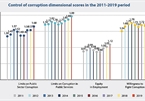 |
|
Minister of Home Affairs Le Vinh Tan.
|
Throughout the nine years of PAR Index and three years of the SIPAS, how have these indexes assisted State agencies, businesses and people?
One of three core targets for State administrative reform in the 2011-20 period was to improve public service quality with the aim of ensuring 80 per cent of citizens and organisations are satisfied with State administrative agencies’ services by 2020.
The measurement of public satisfaction on State services aims to objectively assess the quality of State administrative agencies’ services and their provision, showing that the Government and administrations really serve people.
This is not only a new, difficult job, but also a sensitive task because it requires the Government and administrations to take courage and listen to public feedback.
The rankings help the Government manage task implementation at local, ministerial and sectorial levels.
How do you assess the improvement of the satisfaction level over the years? What is the biggest value gained from that?
The results have shown efforts being made to reform administrative procedures, improve public services and business and public satisfaction.
The results are not based on assessments by State administration and organisations, but instead on the assessment of people and organisations, and demonstrated through statistics.
People and organisations no longer have to visit many offices and meet a lot of officials to complete their public service applications because now there are one-stop-shop units in their localities.
The measurement has helped public administrative agencies to not only recognise the efficiency of their work but also understand what the public expect from public services.
This measurement also helps raise awareness among officials and shapes a culture of putting people and organisations first.
I think the greatest value is that it upholds people's trust in the Government.
The satisfaction level of people not working in the public sector on administrative reform has increased and reached 85.1 per cent this year.
This is a huge foundation for us to continue to accelerate administrative reform in accordance with Government policies towards an e-Government.
The COVID-19 pandemic is also an opportunity to accelerate administrative reform. In the new situation, reforms to management, administrative procedures and mechanisms must be in accordance with public demands to better serve the people.
What stood out from ministries, ministerial-level agencies and localities in 2019?
The average PAR Index at ministerial and provincial levels increased compared to 2018. The gaps between the agencies at the top and the bottom have decreased over the years.
It shows that administrative reforms at ministries and localities have been going at the same pace.
Notably, in 2019, 16 out of 17 ministries and 62 out of 63 localities had higher PAR indexes compared to 2018.
Six out of seven ministerial administrative reform indexes recorded higher points compared to 2018.
Seven out of eight indexes at provincial level gained higher points compared to the previous year.
The positive results show the ministries’ administrative reform in 2019 experienced notable changes.
According to a 2019 survey, the average points for public satisfaction of administrative reform in localities stood at 84.51 per cent. It shows increasing public trust and support in local administrative reform policies.
However, the PAR Index has also revealed shortcomings among ministries and localities. Some ministries have not fully completed tasks assigned by the Prime Minister and the Government in 2019, while others have delayed addressing administrative applications.
The Ministry of Home Affairs is in charge of the Administrative Reform Steering Committee but has never topped or been listed at the bottom of the ranking. What do you think about that?
As an agency which sets the criteria for the ranking, the ministry must ensure equality and transparency. For many years, the ministry has been listed mid-table.
The Ministry of Home Affairs has made progress, and it was the second ministry to launch the one-stop-shop model.
The Ministry of Home Affairs has also applied electronic documents, teleconferences and the use of e-signatures.
However, officers’ profiles are still managed on paper. I expect that information will be managed on a database like Vietnam Social Security soon.
The ministry also needs to build a database on IT applications for administrative management. VNS

Anti-corruption charge in Vietnam commended
Vietnam’s intensified crackdown on corruption has continued to draw praise from the international community.

Quang Ninh tops competitiveness index again
Quang Ninh led all 63 provinces and cities nationwide to top the Provincial Competitive Index (PCI) for the third consecutive year in 2019.
 Minister of Home Affairs Le Vinh Tan talks about the 2019 Public Administration Reform Index (PAR Index) and the Satisfaction Index of Public Administration Services (SIPAS) which were released last week.
Minister of Home Affairs Le Vinh Tan talks about the 2019 Public Administration Reform Index (PAR Index) and the Satisfaction Index of Public Administration Services (SIPAS) which were released last week.